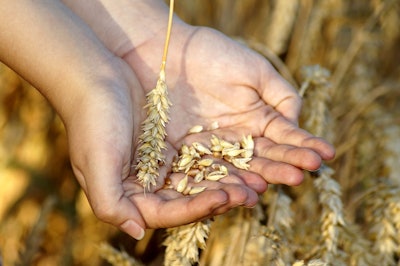
The USDA released its latest World Agricultural Supply and Demand Estimates (WASDE) Thursday.
WHEAT: The 2019/20 U.S. wheat supply and demand outlook is unchanged this month but there were offsetting by-class changes for wheat exports. The projected season-average farm price is $4.80 per bushel, down $0.20 on NASS monthly prices reported to date and expectations for cash and futures prices for the remainder of the marketing year (MY). Global wheat prices are expected to be restrained for the rest of the MY on greater 2019/20 exportable supplies for several major U.S. competitors compared to last year.
The global outlook for wheat this month is for lower supplies, reduced consumption and exports, and higher ending stocks. Supplies are reduced primarily on lower production forecasts for Australia and Kazakhstan on continued dry conditions. Australia’s production is lowered 2 million tons to 19.0 million, mainly on the second consecutive year of drought in New South Wales and Queensland. Kazakhstan’s wheat production is lowered 1.5 million tons to 11.5 million on further deteriorating conditions, and this would be its lowest output since 2012/13. This reduction in global production is tempered by higher carry-in stocks, which results in global supplies less than 1 million tons lower this month. World exports are decreased by 1.8 million tons to 180.8 million on reductions for Australia and Kazakhstan. Global consumption is lowered 1.9 million tons, led by declines for Indonesia, Russia, Uzbekistan, and Ukraine. Despite a reduction this month in global supplies, 2019/20 ending stocks are projected record large at 286.5 million tons with China comprising 51 percent of the total.
COARSE GRAINS: This month’s 2019/20 U.S. corn outlook is for reduced production, lower corn used for ethanol, and slightly higher ending stocks. Corn production is forecast at 13.799 billion bushels, down 102 million from last month on a lower yield forecast. Corn supplies are down from last month, as a smaller crop more than offsets larger beginning stocks due to lower estimated exports and corn used for ethanol for 2018/19. Corn used for ethanol for 2019/20 is lowered 25 million bushels. With use falling more than supply, corn ending stocks are up 9 million bushels from last month. The season-average corn price received by producers is unchanged at $3.60 per bushel.
This month’s 2019/20 foreign coarse grain outlook is for virtually unchanged production, with fractionally lower trade and stocks relative to last month. Ukraine corn production is lowered, as dry conditions during the month of August reduce yield prospects for filling corn. EU corn production is unchanged, as reductions for France and Germany offset increases for Bulgaria and Romania. Barley production is raised for Russia, Ukraine, the EU, and Kazakhstan, but lowered for Australia and Canada.
Major global coarse grain trade changes for 2019/20 include barley export increases for Ukraine, Kazakhstan, and Russia, with a partly offsetting reduction for Australia. For 2018/19, corn exports for Brazil are raised for the local marketing year beginning March WASDE-592-2 2019, based on record large shipments during the month of August. Foreign corn ending stocks for 2019/20 are lower relative to last month, mostly reflecting declines for Brazil, Ukraine, Mexico, Paraguay, and Chile.
RICE: The outlook for 2019/20 U.S. rice this month is for much lower supplies, reduced domestic use and exports, and lower ending stocks. The August 23 NASS Rice Stocks report indicated lower 2018/19 ending stocks than previously estimated, thereby reducing 2019/20 beginning stocks by 5.7 million cwt. In the September Crop Production report, NASS reduced the 2019/20 crop by 18.1 million cwt to 187.3 million on lower harvested area and yields. NASS incorporated FSA certified acreage data this month, and all rice planted area is lowered by 216,000 acres, the result of excessive precipitation at planting time especially in the upper Mississippi River Delta.
Long-grain planted area is lowered 278,000 acres while combined medium- and short-grain area is up 62,000 acres. The average all rice yield is down 14 pounds per acre to 7,563 pounds. Long-grain production is cut 22.4 million cwt and combined medium- and short-grain production is raised 4.4 million. All rice supplies are lowered 23.4 million cwt to 261.8 million, which is 7 percent below last year. Domestic and residual use and exports are each lowered 6.0 million cwt on the lower supplies. All rice ending stocks are lowered 11.4 million cwt to 35.8 million and the season-average farm price is raised $1.00 per cwt to $13.20.
Global 2019/20 supplies are lowered 3.1 million tons, led by a 3.0-million-ton crop reduction for India and a 0.6-million-ton reduction for the United States. Beginning stocks are raised 0.5 million tons. World 2019/20 exports are lowered 1.5 million tons with India down 0.8 million tons on the smaller crop and Thailand down 0.5 million tons on a slow pace and lack of price competitiveness in international markets. Global consumption is cut 1.2 million tons, and world ending stocks are lowered 1.9 million tons to 172.7 million, but both remain record large.
OILSEEDS: U.S. oilseed production for 2019/20 is projected at 110.2 million tons, down 1.3 million from last month with lower soybean and cottonseed production partly offset by a higher peanut forecast. Soybean production is projected at 3.6 billion bushels, down 47 million on a lower yield forecast of 47.9 bushels per acre. Soybean supplies are reduced 2 percent on lower production and beginning stocks. With soybean crush and exports unchanged, ending stocks are projected at 640 million bushels, down 115 million from last month.
The U.S. season-average soybean price for 2019/20 is forecast at $8.50 per bushel, up 10 cents. The soybean meal price is projected at $305 per short ton, up $5.00. The soybean oil price forecast is unchanged at 29.5 cents per pound.
Changes for 2018/19 include higher U.S. soybean exports, higher crush, and lower ending stocks. Exports are increased 45 million bushels based on official trade data through July and indications from August export inspections, which were record high for the month. With crush raised 20 million bushels, ending stocks for 2018/19 are projected at 1.0 billion bushels, down 65 million.
This month’s 2019/20 global oilseed outlook includes lower production, increased trade, and reduced stocks relative to last month. Global rapeseed production is at a 3-year low, mainly reflecting lower production for the EU on both area and yield. Australia’s production is also WASDE-592-3 lowered this month due to dry weather conditions in New South Wales and Queensland. Soybean production is down slightly this month as lower U.S. production is mostly offset by higher output for India, Canada, and China.
Major global oilseed export changes for 2019/20 include higher rapeseed and soybean exports for Canada. For 2018/19, soybean exports for Brazil are lowered based on lowerthan-expected shipments during the past few months. However, higher-than-expected exports by Argentina and the United States, particularly to China, are offsetting. Global soybean ending stocks for 2019/20 are lower as reduced stocks for Argentina and the United States are partly offset by higher stocks for Brazil, Iran, and India.


















